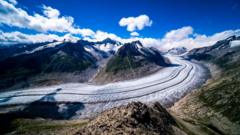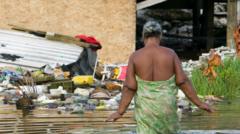A comprehensive study reveals that mountain glaciers have lost a staggering 6,500 billion tonnes of ice since the early 2000s, dramatically affecting freshwater resources and sea levels.
**Rapid Glacier Melting: A Global Climate Alarm**

**Rapid Glacier Melting: A Global Climate Alarm**
Global glaciers are melting at unprecedented rates, posing severe environmental threats.
The world’s glaciers, crucial freshwater reservoirs for millions and indicators of climate shifts, are experiencing alarming rates of melting, far exceeding previous records. A newly published study synthesized data from over 230 regional estimates across 35 research teams, highlighting the gravity of the situation—it has been revealed that glaciers have shed more than 6,500 billion tonnes of ice, equating to about 5% of their mass since the dawn of the 21st century.
The Aletsch Glacier, the largest in the European Alps, exemplifies this loss, having receded approximately 3.2 kilometers since 1900, including over a kilometer since 2000. This melting does not just represent the loss of ice; it poses a looming threat to freshwater resources for billions and a significant driver of rising sea levels, potentially elevating the global tide by as much as 32 centimeters if all glacier ice were to disappear.
Alarmingly, the rate of glacier retreat has intensified, with a third increase in losses compared to the earlier 2000-2011 period. In simpler terms, the average yearly loss of 270 billion tonnes of ice translates to the drinking water consumption for the entire global population over three decades, indicating the magnitude of this issue.
Regions like Central Europe have reported a staggering 39% depletion of glacier ice in merely two decades. The latest findings, published in the prestigious journal Nature, underscore a critical consolidation of evidence rather than merely reiterating the existing consensus on glacier melting. The collaboration among scientists harnesses field measurements and a spectrum of satellite data, allowing a more robust understanding of glacier dynamics.
Crucially, the melting glaciers have delayed responsiveness to climate change, with varying adaptations that could take decades. The future of these ice formations is intrinsically linked to human actions—reductions in greenhouse gas emissions could determine whether up to a quarter or even half of the world’s glacier ice will vanish by century’s end.
As expressed by Michael Zemp, director of the World Glacier Monitoring Service, “Every tenth of a degree of warming that we can avoid will save some glaciers, and will save us from a lot of damage.” The consequences extend beyond the immediate geographic regions, impacting downstream populations reliant on glacial meltwater, further exacerbating drought conditions as glaciers wane.
International sea level rises, additionally fueled by the major ice sheets and thermal expansion of warming ocean waters, continue to accelerate, with global sea levels rising over 20 centimeters since 1900. Warning signs highlight that every centimeter increases flood risks for an additional 2 million people worldwide, showcasing the urgent need for climate action to avert catastrophic future outcomes reminiscent of a world increasingly shaped by disappearing ice.




















